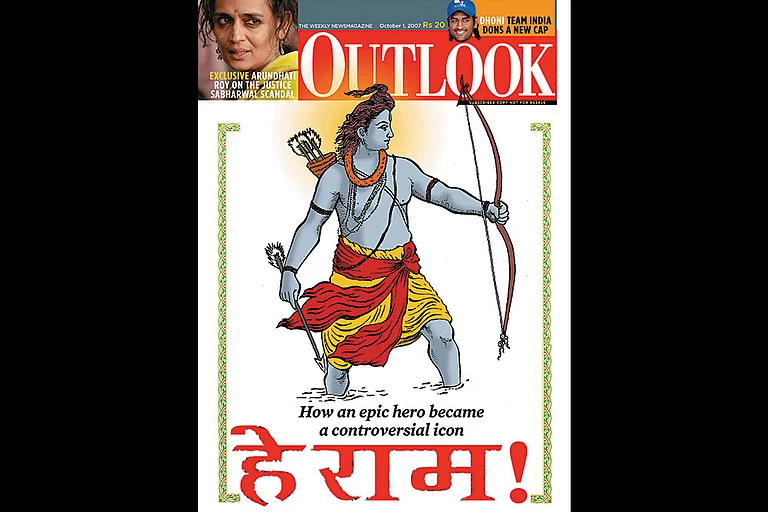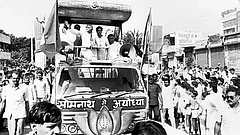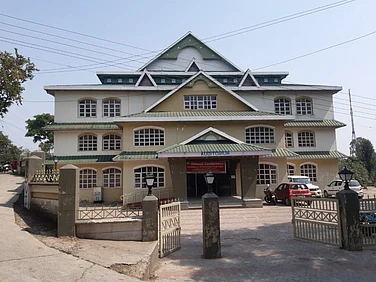A cacophony of sounds created by hammers and pickaxes reverberates through the lanes and by-lanes of Ayodhya days ahead of the inauguration of the Ram temple. Diligent labourers are toiling day and night, giving finishing touches to the temple town. Roads have been widened, pavements built, and the outer facades of buildings around the temple are being embellished with intricate designs.
The yellow and saffron paint on the front walls of the temple is still fresh. The shutters of shops in the vicinity are proudly displaying symbols like trishuls and bow and arrows. There is a fierce-looking Hanuman on one of the shutters.
Ayodhya is all decked up, watching its own rapid transformation.
Residents, however, feel the once-serene town has lost its peaceful charm, giving way to an overwhelming grandiosity that might not resonate well with everyone. The tranquility that once defined Ayodhya has been overshadowed by the imposing new identity of the town itself. While the increased influx of visitors highlights the town’s prominence, it has also led to concerns about overcrowding and potential strain on the local infrastructure. The present-day Ayodhya is a complete contrast to what it was before. Commercialisation has taken centre stage. Locals have been wondering about the cultural implications of this dramatic shift. The transformation, after all, has come at a cost.
In the heart of Ayodhya and around 12 kilometres away from the Ram Janmabhoomi site, the brand-new Maharishi Valmiki International Airport has come up. Nearly 8.3233 hectares of land was acquired from locals, mainly farmers, for the construction of the airport. They were moved to the nearby Ugharpur village, where a mere 0.030 hectares of land was allotted to them. They feel cheated.
The massive demolition drives undertaken to widen roads have also upset residents. Many like Niranjan Shukla, who runs a bhojanalaya (a small restaurant) along the Ram Path, are not happy with the compensation given to them. “Nearly nine months ago, the Ayodhya Development Authority (ADA) demolished a significant portion of my shop. Despite receiving some compensation from the ADA after the reconstruction, due to discrepancies in my shop’s documents, the reimbursement fell significantly short. Today, only a fraction of my shop has been rebuilt.”

Shukla is not alone. There are more who are not impressed with Ayodhya 2.0.
Vinayak Jadhav from Aurangabad (now Sambhajinagar), Maharashtra, who runs a cloth business, ventured on a pilgrimage with his family nearly two months ago, and reached Ayodhya early this year. He was excited to see the refurbished railway station inaugurated by the Prime Minister, which boasts of an AC waiting room and a well-equipped cloak room, and the Saryu Ghat, but he is not sure about the new version of Ayodhya.
He recalls his previous visit to the temple town in 2018. He feels the widened roads bear the scars of transformation, the narrow streets were a lot more charming earlier, and overall commercialisation is an unwelcome change. “The hundreds of hotels and homestays that have sprung up are selling rooms at inflated prices. If this continues, it will discourage the common man from visiting the temple town,” he says, adding that the development of “new Ayodhya” has not been well-rounded.
“The locals are still yearning for some of the basic things,” says Ramesh Kumar Tiwari, a local e-rickshaw driver, who feels the visiting tourists and people from nearby districts, and not the residents, have benefitted from the transformation.
Amid all the euphoria, there are stories of neglect. The Pandey family perfectly understands what the word means. The Pandeys reside in a small, rented home in Rani Bazaar. They don’t know what to make of all the euphoria around. There is a lingering pain. Ramesh Pandey, the head of the family, a kar sevak, lost his life when in October-November 1990 police opened fire at kar sevaks gathered in Ayodhya. He sustained a bullet injury. Over the years, the family has struggled financially and emotionally. In his absence, the responsibility of raising four children fell on his wife Gayatri. She got no support from the government or from the organisations that led the temple movement. The plight of the Pandeys is in complete contrast to the joyous mood in Ayodhya these days. When asked what she feels about the temple, Gayatri remained silent.

Sandeep Gupta, son of Vasudev Gupta—another kar sevak who was killed in 1990—resides near Tulsi Udhyan. The road widening and beautification efforts resulted in the demolition of his home and shop. That angered him, but there was nothing he could do about it. The family of four moved to a rented accommodation close by.
For Gupta, amid all the chaos, there is calm. He believes that the temple’s construction will liberate Ayodhya. The narratives of mandir-masjid, communal tensions and curfews, and the resultant human loss have dragged on for too long, he says. “My father devoted his life to the temple movement. He died fighting for it. Though he is not here, there is a sense of satisfaction in seeing the temple finally take shape. It’s sad though that we have not received an invitation for the inauguration,” says Gupta.
Ravindra Dharkar—who lost his brother, a kar sevak, aged only 17, in 1990—says: “In all these years, the government, the Sangh (RSS) and the Parishad (VHP) remembered us only when the Ram temple issue heated up.” Recounting the fateful day, Dharkar says: “On October 30, 1990, police opened fire on kar sevaks who were gathered around the mosque. Many climbed on the dome to escape tear gas and bullets. My brother was one of them.”
Despite the personal tragedy, the Dharkar family remains loyal to the cause of the construction of the temple. Residing a mere 500 metres from the Ram Janmabhoomi site, their modest dwelling in Kajiyana Mohalla is a testament to their resilience. Ravindra is thrilled about the inauguration despite facing financial hardship because of which his children had to give up on their education. He hopes that the transformation of Ayodhya will also miraculously change the story of his life.
The Ayodhya story, unfortunately, has remained confined to the Ram temple. There are hundreds of temples in the town—most are in dilapidated condition. They are not on any VIP itinerary, so the administration is not doing what they need to do. The residents have stepped in. They have taken it upon themselves to renovate certain structures in Sundar Sadan in Ramkot Mohalla, very close to the Ram temple. However, a blanket ban on any construction activities in the area has halted their efforts. There are many Jain temples, too, that are being neglected.
As the construction of the Ram temple and the transformation of the temple town nears completion, residents feel Ayodhya 2.0 will have to find a balance between progress and heritage, tradition and modernity. But for now, the spotlight is on the inauguration.
MORE FROM THIS ISSUE
(This appeared in the print as 'A Temple Triumphs')
































